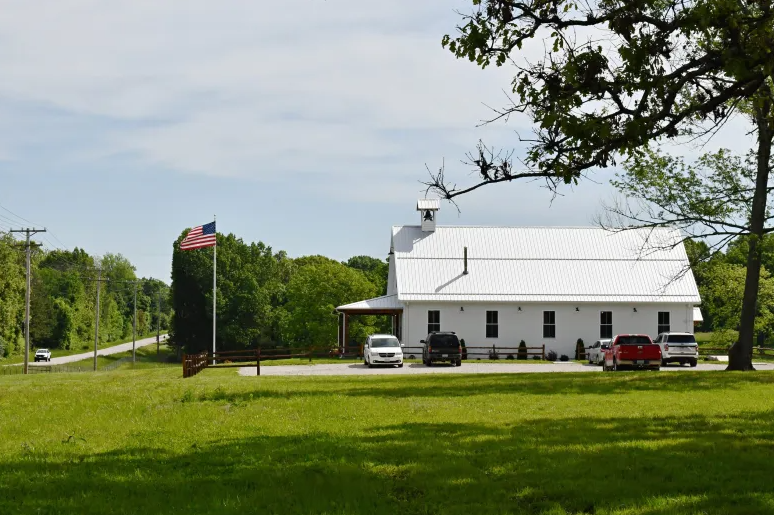This seemingly old-timey form of schooling is reemerging in rural areas where families seek a different education for their children.
For about a century – from after the Civil War through, in some places, the 1960s or so – one-room education was the bedrock of rural Ozarks communities. Kids focused on learning basics like reading, ‘riting and ‘rithmitic that were taught by one teacher in one room.
In southwest Missouri, this form of schooling is reemerging in rural areas where families seek a different style of education for their children.
Some are literally in old schoolhouses that were expected to have seen their last student a good half-century (or more) ago. At least one has been newly built ground-up, an idyllic white building that looks like it could be on the pages of a kids’ story book.
They don’t operate exactly the same as one-room schools once did, but channel close-knit classes, ideals, and beliefs – religious and lifestyle – that their leaders feel are important to instill in younger generations. Technology is very limited, and value is placed on personal character, work ethic, relationship building, and a foundation of faith in the primarily Christian region.
Changing Educational Landscape
In the Missouri Ozarks, one-room schools began disappearing in the late 1940s. The School District Reorganization Law of 1948 was a catalyst in this evolution, aiming to create a more streamlined, educated society in the wake of World War II, creating new guidelines that led many schools to reorganize or consolidate into larger districts.
But today, smaller – or at least more localized – is seen by some as better. That belief is seen through homeschooling, but exactly how many Missouri children are homeschooled is difficult to determine.
The Missouri Department of Elementary and Secondary Education doesn’t oversee private and homeschooled students across the state, its spokesperson told the Daily Yonder. Other small private – often Christian – schools have popped up in larger communities across the region.
The one-room school model is newer, and seems to be reemerging as a desirable option for families seeking education that’s faith-based, and focused on practical skills and less on technology and outside influence.

“Being a Christian, sometimes we’re looked at different,” said Talitha Sims, who has three children enrolled in the Homestead School in rural Taney County, which opened in 2024. “I believe our faith is very strong in our family, and we just wanted our kids to continue to see that every day, and not just at home and in church, but every day.”
Another example is Eminence Christian School in rural Shannon County, Missouri, which uses a one-room schoolhouse model.
“Our number one focus is training up children for an eternity in Heaven,” its website states. “While doing so, we are equipping them to be active community members, have a heart of servitude and stand strong on Godly principles and morals.”
Another, about 40 miles to the west, is in Hutton Valley, Missouri. There, the former two-room school that served kids from the 1930s through the ‘60s, was reopened in 2020 as Neighborhood Christian Schools (NCS), which serves about 40 kids from kindergarten through high school.
NCS students follow the traditional one-room school model: The day is broken into periods that focus on traditional subjects, as well as Bible study and prayer. Kindergarteners are in their own room, but kids from first through sixth grade are in the same room with one teacher. Like a traditional one-room school, more advanced students assist kids at lower levels.
“There’s no reason that first grade has to learn about this time period and second grade has to learn about this time period,” said Joel Hinds, the school’s founder and headmaster. “When you really get down to it, it’s math and it’s reading, and it’s these two or three subjects that build on each other that have to be taught by grade level.
“This is the way they did it for hundreds of years. Just like this. And that’s very doable.”
The Hutton Valley school is one of two rural schools NCS operates. The other, another former one-room school called Forest Dell, is located about 20 miles away. After students complete sixth grade, they consolidate through high school at a church in a nearby town.
“What we find here is the young student — they can skip grades, they can do the work of an older student,” said Hinds. ‘“It’s much less based on your class. It’s based on your ability and your willingness to work. So it’s kind of like real life.”

Not ‘Old School,’ But a Throwback Experience
Now closing its first year, the newly built Homestead Schoolhouse in rural Taney County is about 100 miles west of Hutton Valley and takes a more modern approach to “one-room” schooling.
Instead of all being together in one room for most of the day, some core classes are broken down more into age or skill. However, during other periods – like morning Bible study, recess, and lunch – all kids are together.
It was founded by Brenten and Kimberly Blake, the latter with a degree in teaching, as a place where they wanted to educate their own children. It has about 25 kids from first through eighth grade (with plans to expand into higher grades). The Blakes are pursuing accreditation through the National Association of Private Schools.
“Giving kids a biblical worldview – helping them to think biblically, understand the Bible, understand how it applies to our life,” said Kimberly Blake of the school’s goals, but also helping kids learn practical skills. She tells of a neighbor who works at a grocery store and sees young people who come in and don’t know how to hold a broom.
That’s where Homestead helps. In addition to coursework, the students’ experience includes “life skills” training to recover rural knowledge, like animal husbandry and home economics.
“There was a day in our history when everybody knew how to take care of animals and how to garden and raise those things, and then how to process them and eat them,” Blake said. “Young men always grew up knowing how to build, and women knew how to sew. Those things – they’re kind of a dying art. I think our little niche would be, we’re offering those skills paired with values.”
A greenhouse was recently installed, with plans for future student use. Animals, including chickens, goats, a horse, and a bottle-fed lamb, have been present on the school property this year. Those skills and relationships have resonated with the kids.
“I like seeing my friends, and I also like how we can do life skills. We get to do really fun stuff – we have a lot of presenters come. I really like it,” says Brooklynn Clayton, 10, who comes from both a public and homeschool background. “We got a new little lamb – he’s my favorite right now.”
Similar to NSC, technology is limited at the Homestead School; neither regularly uses technology on the student level, although both schools have a handful of Chromebooks that students can use for research as needed. Both may show educational videos. Curriculum in some subjects is given to multiple ages, but expectations differ between age groups.
“Like with history – [the teacher] gives a lecture, but then every student keeps a notebook, so she’ll require different things of every student,” Blake said. “So Level Two does something different than Level Three. Even though they heard the same lecture, their notebook is going to look a little bit different.”
The students also learn musical instruments, including piano, guitar, and banjo, and have school-based chores that they complete each day. The quality of that work is part of the school’s grading system. And the small nature of those tasks is a strength, Blake said.
“We’ve had parents say to us that they can see improvement in their kids, even at home,” Blake said, such as volunteering to help in ways they didn’t in the past. “It’s been really good for the kids, for sure.”

Not for Everyone
There are a lot of appealing aspects to these schools for folks interested in a more back-to-basics experience. But, as is true with everything in life, the schools’ leaders acknowledge that the concept isn’t ideal for every family.
“Prevention is worth a pound of cure,” said Hinds, the headmaster at NSC. “This may sound bad, but it’s just a reality — in our interview process, we are looking for like-minded families. We really are. We’re not a school for everyone. We’re not a reform school. We just want families that are kind of like-minded. Mom and Dad have to be kind of engaged and paying attention.”
The “one-room” schools are potentially not ideal for kids with special needs who require specialized attention and resources. This is something that educators like Dr. Laurie Edmondson, a professor of education at Ozarks-based Drury University, said is part of the mission of public schools.
“My thought is that public schools were designed to work with every child,” Edmondson wrote in an email. “The teachers are trained, and the progress is monitored through the Missouri Department of Elementary and Secondary Education. Teachers and students are held to state standards and accreditation processes.
“In private schools, teachers and students aren’t necessarily held to those same standards. For example, private schools don’t have to accept every student, and they don’t have to provide special services which are critical in public school settings.”
Generally speaking, Edmondson also notes that, given Missouri’s requirements for home and private schooling, teachers in those settings do not have the same credentialing requirements as public schools. (In the schools mentioned here, Hinds and Blake note that the majority of their teachers do have degrees.)

There are other trade-offs, like sports teams and extracurricular activities. And there is a consensus that the faith-led foundation holds all else that is taught.
But for people like John Kane, whose son attends the Homestead School, the benefits are clear and well worth the 30-minute drive.
“I love everything about it,” Kane told me. “It’s not just the academics, but it’s the physical engagement. The engagement with the animals, the getting outside. My son comes home and he’s all excited because he got to get out the wood chipper and chip wood. Just being more connected to the earth and to life, and to having a practical application and daily life responsibilities.”
“I suppose some people will think, ‘Well, then you miss out on the academics.’ But the reality is, my son, who is seven years old, is a third-grade level or above. He’s also able in that model to advance more at his academic pace, getting the support and attention that he needs. So he’s not losing the academics at all, and he’s getting all the other stuff added to it.”
Whether it’s salvation or academics or better citizens, the long game is the goal for schools like these to have their impact be long-lasting beyond the core academic subjects.
“In some ways, success really won’t be measured for several years – to see if you’re really instilling values in students,” Blake said. In the meantime, “As far as what people could take away: It would just be a place that maybe just took a step back to simplicity.”
Source: dailyyonder.com



